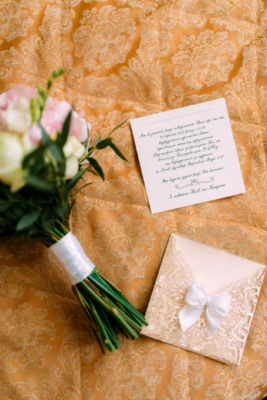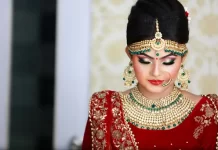 Choosing, designing, and sending wedding invitations can be an etiquette minefield, especially since most couples these days didn’t grow up with the same level of formality in daily life that their parents and grandparents did. Wedding invitation etiquette is based on tradition, but that doesn’t mean it can’t, and doesn’t, evolve with society to meet the changing needs of couples. When your parents got married thirty or forty years ago, the conventions were very different, and society was very different, too.
Choosing, designing, and sending wedding invitations can be an etiquette minefield, especially since most couples these days didn’t grow up with the same level of formality in daily life that their parents and grandparents did. Wedding invitation etiquette is based on tradition, but that doesn’t mean it can’t, and doesn’t, evolve with society to meet the changing needs of couples. When your parents got married thirty or forty years ago, the conventions were very different, and society was very different, too.
These days, the traditional wedding hosted by the bride’s married parents may no longer work for many couples. Couples with divorced and remarried parents, same-sex parents, single parents, or other modern family arrangements need different etiquette for wording their invitations. And they also need different etiquette for addressing invitations to encompass the modern relationships of their attendees. Here’s the wedding invite etiquette your mother won’t be able to give you.
Table of Contents
Include the Vital Information: Who, What, Where, and When
Regardless of who’s hosting your wedding, you need to make sure your wedding invitations include the vital information that people need: the date, time, and location of your ceremony and reception. You should also include information on the dress code, if your guests’ attire is important to you, or if you’re doing something unusual like a costume wedding. Same goes if you’re getting married on the beach or in the woods or in the middle of a field – let guests know how they should dress to be safe and comfortable.
Who’s Hosting?
Here’s where modern wedding invitation etiquette can get tricky. Traditionally, the bride’s married parents host the wedding, and the wedding invitation wording reflects that. It might say, for example, “Mr. and Mrs. David Blum request the honor of your presence at the wedding of their daughter, Julia…”
But maybe the bride’s parents are divorced, and so the wedding is to be hosted by her mother, stepfather, father, and stepmother. Or maybe the bride was raised by a single parent or has only one surviving parent. Maybe the bride’s parents aren’t hosting the wedding at all, but instead the groom’s parents are doing so, or maybe the couple themselves are hosting it.
An easy way to include divorced-and-remarried parents and their new spouses on a wedding invitation is to word it thusly: “Julia Blum and Robert Davis, together with their parents, invite you to celebrate their marriage on…” If the groom’s parents are hosting the wedding, you can write something like, “Mr. and Mrs. John Davis request the pleasure of your company at the wedding of their son, Robert…” If the wife of a couple has a different last name than her spouse, use something like, “Mr. John Davis and Ms. Rebecca Lister invite you to celebrate the wedding of their son…” Usually, married women who do not take their husband’s name prefer the honorific “Ms.,” but you can and should ask.

The same rules can be applied to a single parent – just leave out the spouse. For same-sex parents, use the relevant honorifics: “Mr. and Mr.” for a gay couple, “Ms. and Ms.” for a lesbian couple who don’t share the same last name, and “Mrs. and Mrs.” for a lesbian couple who do share the same name. Again, you can and should ask whether the lesbian couple prefers Ms. or Mrs. If you and your fiancé are hosting your own wedding, you can simply use your own names in the place of your parents.
Address Invitations the Right Way
When it comes to addressing invitations, you should first find out the names and preferred honorifics of any romantic partners your guests may bring, if you don’t already know. When addressing invitations to couples, you can either put the name of the person you know best first on the envelope, or you can write the names in alphabetical order.
When you’re addressing invitations to a married couple, use both the husband’s and wife’s first name, even if she took his name upon marriage: “Mr. Richard Augustus and Mrs. Viola Augustus.” These days, most women don’t go by “Mrs. Husband’s Name,” although, if you’re inviting an older woman, it might be worth asking her about this. Your elderly grandmother, for example, might prefer to be known as “Mrs. Silas Jackson” rather than “Mrs. Priscilla Jackson.” You can apply these same rules to same sex couples: “Mr. Tyler Weatherspoon and Mr. Dan Weatherspoon” or “Mrs. Jane Rugby and Mrs. Ilana Rugby.”
For married couples with different last names, or unmarried couples, use both full names with honorifics: “Ms. Kathryn Moore and Mr. Dylan Stoop” or “Ms. Roberta Cleary and Ms. Megan Sanders.” If a couple is not cohabitating, you should still put both names on the address, but send it to the person you know best, or the one in charge of the social calendar, if you know who that is. If you’re inviting guests who have a domestic or romantic arrangement involving more than two partners, you can simply include the additional name or names and associated honorifics: “Mr. Neal McDonald and Ms. Jenna Robinson and Ms. Joyce Rashid.”
Wedding invitation etiquette has changed over the past few decades, but it remains relatively straightforward, so there’s no need to stress out. Know how your guests prefer to be addressed, remember to include their significant others, and learn everyone’s names. The rest will take care of itself.


















